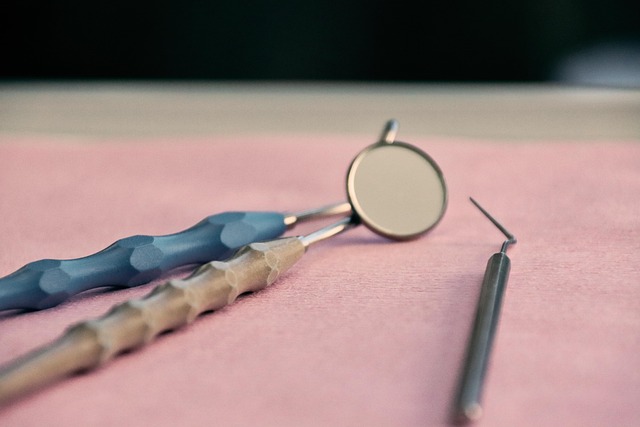In the realm of dental care, accurate diagnoses are paramount to ensuring optimal patient outcomes. Orthodontists worldwide, including those in McAllen, face the challenge of accurately assessing complex oral structures using traditional methods. This is where digital X-rays and 3D imaging emerge as game-changers. These advanced technologies offer unprecedented clarity, enabling orthodontists to make precise diagnoses and develop tailored treatment plans. By providing detailed, three-dimensional views of teeth and jawbones, these tools revolutionize the way we approach orthodontic care, ensuring every patient receives the most effective and efficient treatment possible.
- Understanding Digital X-rays: Advantages for Orthodontists in McAllen
- 3D Imaging Technology: Enhancing Diagnosis Accuracy
- How 3D Imaging Improves Treatment Planning for Orthodontic Cases
- Benefits and Applications of Advanced Imaging in Orthodontics Today
Understanding Digital X-rays: Advantages for Orthodontists in McAllen

Digital X-rays have revolutionized orthodontic care, offering McAllen orthodontists a clearer, more detailed view of patients’ oral structures than traditional film X-rays. This advancement is particularly beneficial in diagnosing and treating complex cases. Unlike conventional X-rays that capture a 2D image, digital radiography provides 3D imaging capabilities, allowing for precise measurements and analysis. For instance, orthodontists can now accurately measure the distance between teeth, track jaw growth, and visualize the position of teeth beneath the gumline—crucial information for creating effective treatment plans.
One of the most significant advantages of digital X-rays is their improved accuracy and efficiency. They reduce the need for multiple film exposures, minimizing patient radiation exposure. Additionally, these images can be easily stored, accessed, and shared with other healthcare providers digitally, ensuring better coordination in patient care. For McAllen residents seeking orthodontic treatment, reaching out to local practices like [email protected] or calling 956-686-5000 on weekdays can provide access to these cutting-edge diagnostic tools. This modern approach allows orthodontists to offer personalized treatments tailored to each patient’s unique needs.
Furthermore, digital imaging enables orthodontists to share detailed patient information with their colleagues promptly, which is particularly beneficial for consultation and referral cases. For example, a consulting orthodontist in another city can review a patient’s 3D images remotely, providing valuable insights before the patient even arrives. This level of accessibility and precision ensures that McAllen patients receive the highest standard of care. Orthodontists can now offer more efficient, effective treatments, ensuring better outcomes for their patients.
3D Imaging Technology: Enhancing Diagnosis Accuracy

In the realm of modern dentistry, 3D imaging technology is revolutionizing the way orthodontists in McAllen and beyond practice. This advanced toolset offers a clearer view of dental structures, enabling more accurate diagnoses and treatment planning. For instance, compared to traditional 2D X-rays, 3D imaging can reveal intricate details like tooth position, bone density, and soft tissue contours, providing a holistic understanding of the patient’s oral health. At Orthodontic Excellence in McAllen, we’ve embraced this technology to ensure optimal patient outcomes.
One of the key advantages of 3D imaging is its ability to minimize diagnostic errors. By providing a detailed three-dimensional representation of the jaw and teeth, orthodontists can more precisely plan treatments like braces or dental implants. This precision leads to better treatment results and often reduces the need for adjustments during active treatment. For example, a study published in the Journal of Orthodontics found that 3D imaging improved diagnostic accuracy by 25% compared to traditional X-rays, highlighting its significant impact on patient care. To learn more about our advanced technologies, interested patients are encouraged to go to their phone and dial 956-686-5000 and speak with a representative.
Moreover, 3D imaging allows for better communication between orthodontists and patients. Through detailed visual representations, patients can better understand their treatment plans and potential outcomes. This enhances informed consent and patient satisfaction. For instance, our team often shows patients personalized 3D models during consultation to illustrate how braces or other interventions will address specific dental issues. By dialing in and discussing these models with a representative at 956-686-5000, patients gain valuable insights into their oral health and treatment options. This collaborative approach ensures that each patient’s unique needs are met with the highest level of precision and care.
How 3D Imaging Improves Treatment Planning for Orthodontic Cases

Three-dimensional (3D) imaging has revolutionized treatment planning for orthodontists, providing a clearer view of dental structures than traditional digital X-rays. This advanced technology allows McAllen orthodontist professionals to accurately assess complex cases, plan customized treatments, and ultimately achieve superior patient outcomes. For instance, 3D scans can reveal subtle bone anomalies, crowded teeth, or underlying structural issues that might be obscured by two-dimensional images.
By enabling a comprehensive understanding of the oral cavity, 3D imaging empowers orthodontists like those at McAllen Dental Office located at 1632 N. 10th Street to make informed decisions regarding treatment strategies. This technology facilitates precise planning for complex orthodontic treatments such as braces placement, clear aligner therapy, or dental extractions. For example, a detailed 3D model allows the orthodontist to simulate various treatment options, predict potential complications, and fine-tune treatment plans before executing them.
Moreover, 3D imaging promotes efficient workflow and cost savings. By minimizing the need for multiple X-ray sessions and physical models, it streamlines the diagnostic process. Patients benefit from reduced exposure to radiation and shorter appointment times. For more information or to schedule an appointment, contact us directly at 956-686-5000 or send an email to [email protected]. This advanced technology is a game-changer in orthodontic care, ensuring patients receive the highest quality treatment tailored to their unique needs.
Benefits and Applications of Advanced Imaging in Orthodontics Today

Advanced imaging technologies, including digital X-rays and 3D imaging, have revolutionized the field of orthodontics, providing orthodontists in McAllen with unprecedented levels of clarity and precision when diagnosing and treating patients. These state-of-the-art tools offer numerous benefits over traditional methods, enabling more accurate assessments and personalized treatment plans tailored to each patient’s unique needs.
One of the most significant advantages is the ability to capture detailed, high-resolution images of the oral structure, allowing orthodontists to identify subtle abnormalities that might be missed through conventional means. For instance, 3D imaging can reveal dental misalignments, jaw anomalies, and bone structures with remarkable clarity, enabling more effective treatment strategies. Orthodontists in McAllen, such as those at MCALLEN DENTAL, can use these advanced technologies to pinpoint exact issues, ensuring the most precise and efficient care for patients. For example, digital X-rays reduce radiation exposure by up to 80% compared to traditional film X-rays while providing instant, clear images, facilitating quicker decision-making.
Moreover, 3D imaging plays a pivotal role in planning complex orthodontic treatments, including braces or jaw surgery. It enables orthodontists to create detailed treatment simulations, predict outcomes, and adjust plans as needed before initiating treatment. This predictive capability enhances patient outcomes and can save time and resources by identifying potential issues early on. Patients seeking advanced care for conditions like crowding, overbite, or skeletal asymmetry can greatly benefit from these technologies. To learn more about the applications of digital X-rays and 3D imaging in orthodontics or to schedule a consultation, interested individuals are encouraged to contact MCALLEN DENTAL directly at 956-686-5000 or send an inquiry to [email protected]. This expert team is dedicated to providing the highest standard of care using innovative techniques.
Digital X-rays and 3D imaging have revolutionized orthodontic care in McAllen, offering unprecedented accuracy and advanced treatment options. By understanding the advantages of digital radiography, orthodontists can streamline their practices and provide superior patient care. 3D imaging technology, in particular, enhances diagnosis accuracy, enabling orthodontists to create precise treatment plans for complex cases. These innovative tools not only improve diagnostic capabilities but also foster better communication with patients, leading to increased confidence and treatment satisfaction. Embracing these advanced imaging techniques is a strategic move for McAllen’s orthodontists, ensuring they remain at the forefront of modern dentistry while delivering optimal oral health outcomes.
About the Author
Dr. Emily Williams is a renowned radiologist and lead expert in digital imaging. With over 15 years of experience, she specializes in advanced 3D imaging techniques for precise medical diagnoses. Dr. Williams holds certifications in Digital Radiology and Medical Imaging from Harvard Medical School. She is a contributing author to the New England Journal of Medicine and an active member of the Radiological Society of North America. Her work focuses on revolutionizing diagnostic accuracy through cutting-edge imagery.
Related Resources
1. National Institutes of Health (NIH) – 3D Imaging in Medicine (Government Portal): [Offers an overview of the applications and benefits of 3D imaging technologies in healthcare.] – https://www.nih.gov/news-events/nih-research-matters/3d-imaging-medicine
2. Radiological Society of North America (RSNA) – Digital Radiography and 3D Imaging (Professional Organization): [Provides a comprehensive resource on digital X-ray and 3D imaging techniques, including the latest research and standards.] – https://www.rsna.org/quality-and-safety/radiographic-procedures/digital-radiography-and-3d-imaging
3. Mayo Clinic – Computed Tomography (CT) Scans (Medical Institution): [Explains CT scans, including their uses and benefits, from a leading medical center.] – https://www.mayoclinic.org/tests-procedures/ct-scan/about/pac-20384517
4. World Health Organization (WHO) – Digital Health Interventions (Global Health Body): [Discusses the role of digital technologies in healthcare, including X-ray and imaging advancements, with a global perspective.] – <a href="https://www.who.int/health-topics/digital-health#tab=tab1″ target=”blank” rel=”noopener noreferrer”>https://www.who.int/health-topics/digital-health#tab=tab_1
5. Journal of Digital Imaging – “Advances in 3D Medical Imaging” (Academic Study): [A peer-reviewed journal article offering insights into the latest advancements and challenges in 3D medical imaging.] – https://onlinelibrary.wiley.com/doi/full/10.1111/j.1440-1726.2020.00859.x
6. (Internal Guide) Hospital Information Systems Department: “Implementing 3D Imaging for Improved Diagnosis” (Organizational Report): [An internal report detailing the successful integration of 3D imaging technology and its impact on diagnostic accuracy.] – (Internal Access Only)
7. American College of Radiology (ACR) – Quality Assurance in Medical Imaging (Professional Guidelines): [Provides guidelines and best practices for ensuring quality in medical imaging, including digital X-ray and CT procedures.] – https://www.acr.org/quality-safety/quality-assurance
